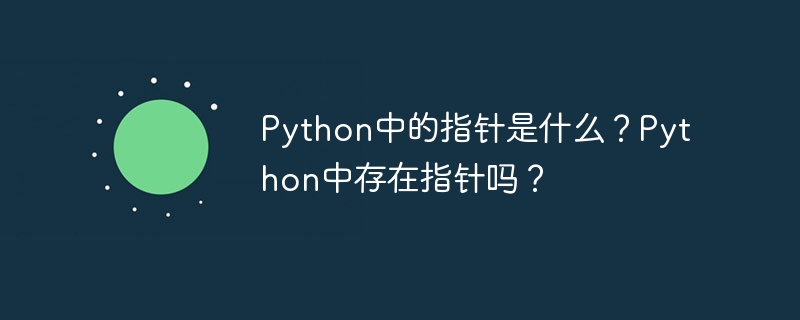Python中的指针是什么?Python中存在指针吗?

低级编程语言,如C或C++,经常使用指针来直接处理内存。它们能够实现有效的内存管理和低级数据操作。
The low-level complexities of memory administration are abstracted away in Python, a high-level language. Because of this, Python lacks express pointers in an equal manner that C or C++. As an alternative, Python makes use of an idea comparable to this one known as references, which enables indirect access to objects in memory by variables. Python gives builders a sturdy toolkit without requiring them to have a thorough appreciation of low-level memory administration through the use of references and other high-level abstractions.
在Python中,一切都是对象,对象保存在内存中。实际上,当你在Python中定义一个变量时,你正在创建一个对对象的引用。这个引用实际上充当了指向对象在内存中存储位置的指针。
考虑下面的代码,例如。
a = 5 b = a
a = 5 − The Python statement "a = 5" declares a new variable and gives it the integer value of 5. Python produces a new integer object with the value 5 when this line is performed, and it then assigns a reference to that object to the variable a.
b = a − In a comparable way, the statement b = a declares a new variable b and offers it the value of a. Since an object (in this case, an integer object with value 5) is referenced through an object (a), then object (b) is likewise referenced by using an object (a). As a result, references to the identical 5-valued integer object are now shared by way of each a and b.
This is important because it means that changes made to a will also be reflected in b since they are both referencing the same object. For example −
Example
a = 5 b = a a = 6 print(b)
Output
5
As anticipated, yes? To understand the code sample above, follow these easy steps −
a = 5 − 这行代码创建了一个名为a的新变量,并将其赋值为5。
b = a − A new variable b is created and assigned the value of a. Variable b holds the integer value of 5 which is the same as variable a.
a = 6 − This changes the integer value of the variable a to a new value of 6. A now has a reference to a different integer object than b at this time.
print(b) − This commands outputs b's value to the console. The output of this line is 5 since b still has a reference to the initial integer object with the value of 5.
Memory management is an essential issue of programming, and Python makes use of computerized garbage collection to manage it. The garbage collector of Python takes care of memory allocation and deallocation automatically whereas, in C or C++, developers take the responsibility for memory management.
Python的垃圾回收器会在不再需要通过变量引用的对象时自动从内存中删除它们。
This eliminates the want for guided memory management and frees builders to center their attention on writing code, rather than being traumatic about releasing memory. Ultimately, Python's automatic garbage series provides an extra simple and much less error-prone way of handling reminiscence management.
结论
总之,Python不再像C或C++那样有显式指针,但它使用引用,这是可比较的概念。Python将所有东西都作为对象提供,变量作为指向这些对象的指针。因此,每当您将一个值赋给一个变量,这意味着您正在指向内存中的某个东西。理解Python的引用系统很重要,因为它是语言管理内存的关键组成部分。
通过理解引用,您可以更好地了解通过引用它们的变量传播对象的修改方式。这可以帮助您编写更高效和有利的代码,并避免与内存管理相关的常见陷阱。因此,了解引用是成为熟练的Python程序员的重要一步。
以上是Python中的指针是什么?Python中存在指针吗?的详细内容。更多信息请关注PHP中文网其他相关文章!

热AI工具

Undresser.AI Undress
人工智能驱动的应用程序,用于创建逼真的裸体照片

AI Clothes Remover
用于从照片中去除衣服的在线人工智能工具。

Undress AI Tool
免费脱衣服图片

Clothoff.io
AI脱衣机

AI Hentai Generator
免费生成ai无尽的。

热门文章

热工具

记事本++7.3.1
好用且免费的代码编辑器

SublimeText3汉化版
中文版,非常好用

禅工作室 13.0.1
功能强大的PHP集成开发环境

Dreamweaver CS6
视觉化网页开发工具

SublimeText3 Mac版
神级代码编辑软件(SublimeText3)

热门话题
 mysql 是否要付费
Apr 08, 2025 pm 05:36 PM
mysql 是否要付费
Apr 08, 2025 pm 05:36 PM
MySQL 有免费的社区版和收费的企业版。社区版可免费使用和修改,但支持有限,适合稳定性要求不高、技术能力强的应用。企业版提供全面商业支持,适合需要稳定可靠、高性能数据库且愿意为支持买单的应用。选择版本时考虑的因素包括应用关键性、预算和技术技能。没有完美的选项,只有最合适的方案,需根据具体情况谨慎选择。
 mysql安装后怎么使用
Apr 08, 2025 am 11:48 AM
mysql安装后怎么使用
Apr 08, 2025 am 11:48 AM
文章介绍了MySQL数据库的上手操作。首先,需安装MySQL客户端,如MySQLWorkbench或命令行客户端。1.使用mysql-uroot-p命令连接服务器,并使用root账户密码登录;2.使用CREATEDATABASE创建数据库,USE选择数据库;3.使用CREATETABLE创建表,定义字段及数据类型;4.使用INSERTINTO插入数据,SELECT查询数据,UPDATE更新数据,DELETE删除数据。熟练掌握这些步骤,并学习处理常见问题和优化数据库性能,才能高效使用MySQL。
 如何针对高负载应用程序优化 MySQL 性能?
Apr 08, 2025 pm 06:03 PM
如何针对高负载应用程序优化 MySQL 性能?
Apr 08, 2025 pm 06:03 PM
MySQL数据库性能优化指南在资源密集型应用中,MySQL数据库扮演着至关重要的角色,负责管理海量事务。然而,随着应用规模的扩大,数据库性能瓶颈往往成为制约因素。本文将探讨一系列行之有效的MySQL性能优化策略,确保您的应用在高负载下依然保持高效响应。我们将结合实际案例,深入讲解索引、查询优化、数据库设计以及缓存等关键技术。1.数据库架构设计优化合理的数据库架构是MySQL性能优化的基石。以下是一些核心原则:选择合适的数据类型选择最小的、符合需求的数据类型,既能节省存储空间,又能提升数据处理速度
 HadiDB:Python 中的轻量级、可水平扩展的数据库
Apr 08, 2025 pm 06:12 PM
HadiDB:Python 中的轻量级、可水平扩展的数据库
Apr 08, 2025 pm 06:12 PM
HadiDB:轻量级、高水平可扩展的Python数据库HadiDB(hadidb)是一个用Python编写的轻量级数据库,具备高度水平的可扩展性。安装HadiDB使用pip安装:pipinstallhadidb用户管理创建用户:createuser()方法创建一个新用户。authentication()方法验证用户身份。fromhadidb.operationimportuseruser_obj=user("admin","admin")user_obj.
 Navicat查看MongoDB数据库密码的方法
Apr 08, 2025 pm 09:39 PM
Navicat查看MongoDB数据库密码的方法
Apr 08, 2025 pm 09:39 PM
直接通过 Navicat 查看 MongoDB 密码是不可能的,因为它以哈希值形式存储。取回丢失密码的方法:1. 重置密码;2. 检查配置文件(可能包含哈希值);3. 检查代码(可能硬编码密码)。
 mysql 需要互联网吗
Apr 08, 2025 pm 02:18 PM
mysql 需要互联网吗
Apr 08, 2025 pm 02:18 PM
MySQL 可在无需网络连接的情况下运行,进行基本的数据存储和管理。但是,对于与其他系统交互、远程访问或使用高级功能(如复制和集群)的情况,则需要网络连接。此外,安全措施(如防火墙)、性能优化(选择合适的网络连接)和数据备份对于连接到互联网的 MySQL 数据库至关重要。
 mysql workbench 可以连接到 mariadb 吗
Apr 08, 2025 pm 02:33 PM
mysql workbench 可以连接到 mariadb 吗
Apr 08, 2025 pm 02:33 PM
MySQL Workbench 可以连接 MariaDB,前提是配置正确。首先选择 "MariaDB" 作为连接器类型。在连接配置中,正确设置 HOST、PORT、USER、PASSWORD 和 DATABASE。测试连接时,检查 MariaDB 服务是否启动,用户名和密码是否正确,端口号是否正确,防火墙是否允许连接,以及数据库是否存在。高级用法中,使用连接池技术优化性能。常见错误包括权限不足、网络连接问题等,调试错误时仔细分析错误信息和使用调试工具。优化网络配置可以提升性能
 mysql 需要服务器吗
Apr 08, 2025 pm 02:12 PM
mysql 需要服务器吗
Apr 08, 2025 pm 02:12 PM
对于生产环境,通常需要一台服务器来运行 MySQL,原因包括性能、可靠性、安全性和可扩展性。服务器通常拥有更强大的硬件、冗余配置和更严格的安全措施。对于小型、低负载应用,可在本地机器运行 MySQL,但需谨慎考虑资源消耗、安全风险和维护成本。如需更高的可靠性和安全性,应将 MySQL 部署到云服务器或其他服务器上。选择合适的服务器配置需要根据应用负载和数据量进行评估。






